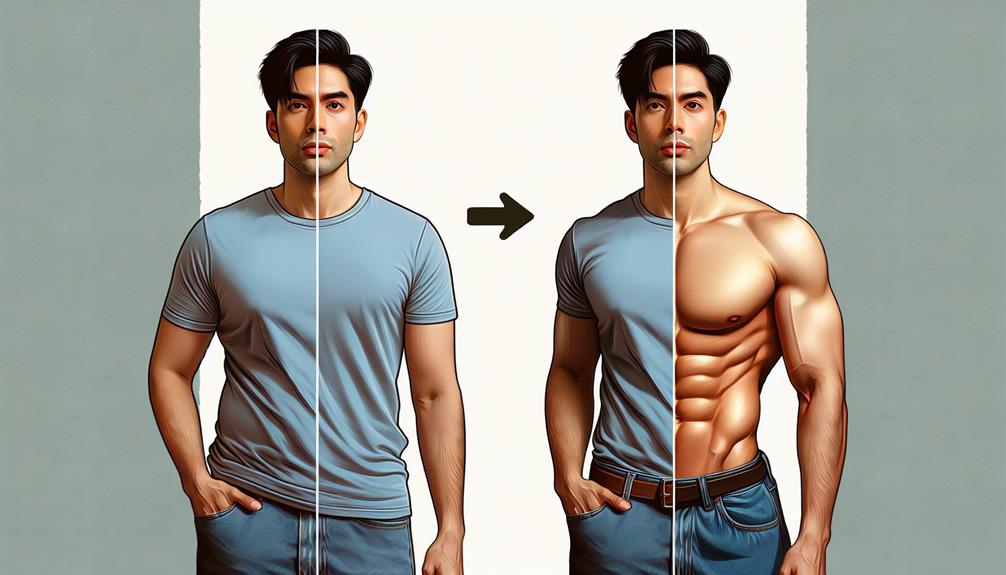Imagine you're standing in front of a cluttered closet, overwhelmed by the sheer amount of clothes and accessories. You know you need to declutter and organize, but where to start? Just like tidying up your physical space, embarking on a weight loss journey can feel daunting. But fear not, because intermittent fasting is here to help you navigate through the chaos and simplify your path to a healthier you. With its flexible approach, intermittent fasting has gained popularity as an effective tool for weight loss. In this beginner's guide, we'll unravel the science behind intermittent fasting, explore different fasting methods, discuss the benefits, and provide you with practical tips to kickstart your journey towards a leaner, fitter version of yourself. So, are you ready to unlock the secrets of intermittent fasting and discover a sustainable way to shed those extra pounds?
Key Takeaways
- Intermittent fasting involves alternating periods of fasting and eating, and is popular for weight loss and overall health benefits.
- Different methods of intermittent fasting include the 16/8 method, 5:2 diet, alternate-day fasting, Eat-Stop-Eat, and the Warrior Diet.
- Intermittent fasting offers benefits such as reducing inflammation, improving insulin sensitivity, regulating blood sugar levels, promoting weight loss and metabolic health, and overall health benefits.
- To get started with intermittent fasting, it is important to educate oneself on different methods, consult a healthcare professional, download an intermittent fasting app, start slowly with shorter fasting periods, and avoid common mistakes like overeating and not staying hydrated.
What Is Intermittent Fasting?
Intermittent fasting is a dietary approach that involves alternating periods of fasting and eating, and it has gained popularity for its potential benefits in weight loss and overall health. There are different methods of intermittent fasting, each with its own unique fasting and eating windows. The most popular fasting schedules include the 16/8 method, the 5:2 diet, and the alternate-day fasting.
The 16/8 method involves fasting for 16 hours and restricting your eating window to 8 hours. This can be achieved by skipping breakfast and starting your eating window at noon, and then stopping eating by 8pm. The 5:2 diet involves eating normally for five days a week and restricting calorie intake to 500-600 calories for the remaining two days. Lastly, alternate-day fasting involves fasting every other day, where you eat normally on one day and restrict calorie intake to 500-600 calories on the fasting day.
These popular fasting schedules provide flexibility and can be tailored to fit your lifestyle. It is important to choose a method that works best for you and consult with a healthcare professional before starting any fasting regimen. Remember to stay hydrated and nourish your body with nutrient-dense foods during your eating window to support overall health and well-being.
Different Types of Intermittent Fasting
Now let's explore the various types of intermittent fasting that you can incorporate into your weight loss journey. There are several alternate fasting methods that have become popular intermittent fasting schedules. Here are five of them:
- 16/8 method: This involves fasting for 16 hours and restricting your eating window to 8 hours. For example, you might skip breakfast and only eat between 12 pm and 8 pm.
- 5:2 diet: With this method, you eat normally for five days of the week and restrict your calorie intake to 500-600 calories for the remaining two days. These two days don't have to be consecutive.
- Eat-Stop-Eat: This approach involves fasting for 24 hours once or twice a week. For example, you might finish dinner at 7 pm and not eat until 7 pm the next day.
- Alternate-day fasting: As the name suggests, this method involves alternating between fasting days and regular eating days. On fasting days, you typically consume 500-600 calories.
- Warrior Diet: This approach involves fasting during the day and having one large meal at night. You can eat small amounts of fruits and vegetables during the day if needed.
These are just a few examples of intermittent fasting schedules that you can choose from. It's important to find the one that suits your lifestyle and preferences best. Remember to consult with a healthcare professional before starting any new diet or fasting regimen.
Benefits of Intermittent Fasting for Weight Loss

To achieve successful weight loss, incorporating intermittent fasting into your routine offers a range of benefits. One of the key advantages of intermittent fasting is its ability to reduce inflammation in the body. Inflammation is a natural response to injury or illness, but chronic inflammation can contribute to weight gain and various health issues. Studies have shown that intermittent fasting can help decrease levels of inflammatory markers in the body, promoting overall health and weight loss.
Additionally, intermittent fasting has been found to improve insulin sensitivity. Insulin is a hormone that regulates blood sugar levels, and when the body becomes resistant to its effects, it can lead to weight gain and an increased risk of type 2 diabetes. By implementing intermittent fasting, you give your body a break from constantly digesting food, which allows insulin levels to stabilize and improve sensitivity. This can help your body more effectively regulate blood sugar levels, leading to weight loss and better overall metabolic health.
How to Get Started With Intermittent Fasting
To successfully begin incorporating intermittent fasting into your routine for weight loss, follow these practical steps:
- Educate yourself: Before starting intermittent fasting, it's important to understand the different methods and their potential benefits. Research the 16/8 method, the 5:2 diet, and alternate-day fasting to find the approach that suits you best.
- Consult a healthcare professional: It's always a good idea to speak with a healthcare professional before making any significant changes to your diet. They can provide personalized advice and address any concerns or health conditions you may have.
- Download an intermittent fasting app: There are several apps available that can help you track your fasting hours and provide guidance on when to eat. Examples include Zero, FastHabit, and Life Fasting Tracker.
- Start slowly: If you're new to intermittent fasting, it's best to ease into it. Begin with shorter fasting periods, such as 12 hours, and gradually increase the duration as you become more comfortable.
- Avoid common mistakes: Some common mistakes to watch out for include overeating during your eating window, not staying properly hydrated, and not consuming enough nutrients during your eating periods. Be mindful of these pitfalls and make adjustments as needed.
Tips for Successful Intermittent Fasting Journey

For a successful intermittent fasting journey, implementing these practical tips will help you achieve your weight loss goals.
- Start Slowly: Don't jump into fasting for long periods right away. Begin with shorter fasting periods, and gradually increase the duration as your body adapts.
- Stay Hydrated: Drink plenty of water during fasting periods to stay hydrated and curb hunger.
- Choose Nutrient-Dense Foods: When breaking your fast, opt for nutrient-dense foods like fruits, vegetables, lean proteins, and whole grains to fuel your body properly.
- Plan Your Meals: Plan your meals ahead of time to ensure you have healthy options available and can avoid impulsive, unhealthy food choices.
- Listen to Your Body: Pay attention to your body's hunger and fullness cues. Eat until you're satisfied, not until you're stuffed.
- Stay Active: Incorporate regular exercise into your routine. It can help boost your metabolism and maintain muscle mass while fasting.
- Get Enough Sleep: Aim for seven to eight hours of quality sleep each night. A well-rested body is better equipped to manage hunger and cravings.
- Seek Support: Join online communities or find a fasting buddy to share your experiences, get advice, and stay motivated.
Frequently Asked Questions
Can Intermittent Fasting Help Me Gain Muscle?
Intermittent fasting can help you gain muscle by promoting the release of growth hormone and increasing protein synthesis. By combining fasting with a balanced diet and regular resistance training, you can maximize muscle gain with intermittent fasting.
Can I Drink Coffee or Tea During the Fasting Period?
Sure, you can have coffee or tea during your fasting period. Just be mindful that adding sugar or cream can break your fast. Stick to black coffee or unsweetened tea for the best results.
Will Intermittent Fasting Slow Down My Metabolism?
Intermittent fasting can actually help boost your metabolism by promoting fat burning and preserving muscle mass. While weight loss may plateau at times, adjusting your fasting schedule or incorporating exercise can help overcome this.
Can Intermittent Fasting Help Reduce Cravings for Unhealthy Foods?
Intermittent fasting can help reduce cravings for unhealthy foods. By improving insulin sensitivity and providing mental clarity, it allows you to make better food choices. Say goodbye to those pesky cravings!
Can Intermittent Fasting Be Done Long-Term or Is It Just a Short-Term Weight Loss Strategy?
Intermittent fasting can be a sustainable long-term weight loss strategy. It has numerous benefits like improved insulin sensitivity and increased autophagy. Just make sure to follow a balanced diet during your eating windows.
Conclusion
In conclusion, intermittent fasting can be a practical and effective approach for weight loss. By incorporating periods of fasting into your routine, you can tap into your body's natural fat-burning mechanisms and promote overall health. Whether you choose the 16/8 method or alternate-day fasting, this approach has been shown to offer numerous benefits, including improved insulin sensitivity and reduced inflammation. So why not give it a try and unlock the potential for a healthier, leaner you? Remember, Rome wasn't built in a day, so be patient and consistent on your intermittent fasting journey.













